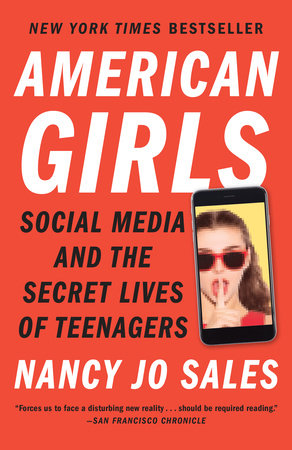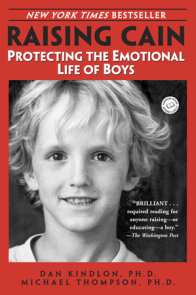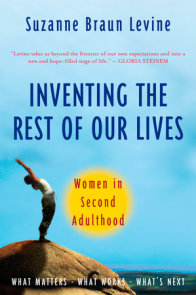READERS GUIDE
Dear Parents,As a journalist who has covered teenagers for twenty years, and as the mother of a teenage girl, writing American Girls was very important to me. I’m so grateful to you for reading it and discussing it with your children and fellow parents. As I say in the book, I feel the stakes for girls could not be higher. As parents we need to know what is happening with our children on social media, and what we can do to help them navigate through the unprecedented challenges they face with this new technology. American Girls is not a parenting book, but I hope the information it provides and the testimonies of the girls I interviewed will form the basis of an understanding of what girls around the country are experiencing online. Every parent has to decide for him- or herself how to respond. Girls I interviewed told me that they want and need our guidance, and I feel it is our responsibility to give it. It all begins with a conversation.
–Nancy Jo Sales
Think about it:
*Seventy-three percent of kids have smartphones.
*Teenagers spend up to eleven hours a day plugged into an electronic device.
*Kids begin seeing online porn as young as age six, and the majority of boys and girls have watched it before they turn eighteen.
*Ninety-two percent of American children have an online presence before the age of two.
*Seven percent of Tinder’s estimated 50 million users are between the ages of thirteen and seventeen.
*In 2015, girls exchanged 40 to 50 texts a day (Pew study). Other studies found the number to be more than 100.
Social media platforms your children are probably using:
Ask.fm – a Q&A-style platform where users post personal information and invite others to ask questions and make comments, which they can do anonymously
Facebook – a social networking site where users create profiles featuring pictures and personal information, including geographic information. The platform allows for communication between profiles, creation of groups and events, and offers a stream of “friend activity” via a newsfeed.
GroupMe – a mobile app that offers free group text messaging. It allows for easy exchange of pictures, videos, and Web links. Users can also send private messages, but only to someone who also has the GroupMe app.
iMessage – Apple’s proprietary instant-messaging service, which allows sending of text, photo, video, and audio messages from the iOS platform and features group messaging
Instagram – photo- and video-sharing social media app where users create profiles, follow other profiles, and comment on and like images or videos. Unlike on Facebook, following a profile on Instagram is not symmetrical, so connections are not always mutual. In addition to posting content publicly, a user can also privately share photos or videos with one of his or her followers or a group of followers. Instagram profiles can be made private, requiring the user to give permission before someone can begin viewing their content.
Kik Messenger – an instant-messaging service available on mobile phones. Users can remain anonymous on this platform.
Periscope – a live video-streaming app. The streaming video can be made public or viewable to only certain users.
Pinterest – a social network that allows users to visually share and discover new interests by “pinning” images or videos to their own or others’ boards and browsing what other users have pinned. Functions as a sort of online mood board.
Reddit – an entertainment, social networking, and news website where registered community members can submit content, such as text posts or direct links in the manner of an online bulletin board system.
Snapchat – a photo- and video-messaging app where images are sent to a specific follower and then disappear after a set amount of time, or are available as a “story” that is broadcast to all of the user’s followers for twenty-four hours. Users add each other as friends or follow stories of fellow users. Snapchat users receive immediate information on who has opened their Snaps or watched their Snapchat Stories.
Tinder – a location-based dating app that facilitates communication between mutually interested users, allowing matched users to chat. Users swipe right (interested) or left (not interested). Once a match is made, the users can begin messaging each other inside the Tinder app.
Tumblr – a micro-blogging platform and social networking website for sharing and following user-generated content.
Twitter – a social networking service that allows users to broadcast short posts of 140 characters or fewer called tweets. Users can also broadcast photos and videos in their tweets. As on Instagram, users have followers and follow other profiles, but the connection is not always mutual.
Vine – a video-sharing platform of looped files between three and six seconds long.
Yik Yak – an app for participating in anonymous discussion threads within a five-mile radius.
YouTube – a video-sharing website. Users can create profiles and channels, which other users subscribe to in order to see updates. Users can also leave comments on video posts.
—
What we mean when we talk about sexism on social media:
agency – Independence of choice and action, self-definition and self-direction
double standard – A set of principles that applies differently and usually more rigorously to one group of people or circumstances than to another; especially a code of morals that applies more severe standards of sexual behavior to women than it does to men
feminism – The belief that men and women should have equal rights and opportunities; a political discourse and movement aimed at transformation away from patriarchy and toward a society free from gender oppression
media – The main means of mass communication (especially television, radio, newspapers, and the Internet) regarded collectively
misogyny – Dislike of, contempt for, or ingrained prejudice against women
objectification – When a person is defined by her/his sexual attributes and the rest of her/his personality and existence are ignored; objectification involves the reduction of a person to an object for someone else’s gaze or pleasure
patriarchy – A society or social system that is controlled by men or in which men hold a disproportionate share of the power
rape culture – A society in which rape is pervasive and normalized due to societal attitudes about gender, sex, and sexuality
sexism – Prejudice, stereotyping, or discrimination, typically against women, on the basis of sex
sex-positive – The idea that all sex and expressions of sexuality, as long as they are healthy and explicitly consensual, are positive things. Sex positivity stresses informed consent and agency within one’s own sexuality and aims to remove stigma and shame from all sexual choices.
sexual harassment – Unwelcome sexual advances, requests for sexual favors, and other verbal or physical conduct of a sexual nature
sexualization – When a person’s value is defined by his or her sexual appeal or behavior, to the exclusion of other characteristics, or when a person is made into a object for others’ sexual use, rather than seen as a person with the capacity for independent action and decision-making. Sexualization also occurs when sexuality is inappropriately imposed upon a person.
slut-shaming – Attacking a person for being sexual, having one or more sexual partners, acknowledging sexual feelings, and/or acting on sexual feelings, especially as pertains to the sexual activity of girls and women (see double standard)
victim-blaming – When the victim of a crime, an accident, or any type of abusive maltreatment is held to be wholly or partially responsible for the wrongful conduct committed against her or him
War on Women – An expression used in United States to describe certain Republican Party policies and legislation as a wide-scale effort to restrict women’s rights, especially reproductive rights
Questions and Topics for Discussion
1. Studies say that teenage girls use social media more than anyone else, while other studies show that many parents are posting about their children from birth (pp. 31–34). Do you post on social media about your kids? What kind of posts, and how often? What effect do you think this has on them?
2. Many girls expressed to author Nancy Jo Sales the feeling that they were “addicted” to social media. Do you think your daughter seems “addicted” or that she is on social media more than she should be? Have you ever talked to her about this or tried to find ways to limit her social media use? Why or why not?
3. While reporting for American Girls, Sales spoke to parents who had virtually no idea what their daughters were doing on social media. How aware are you of your daughter’s social media use? Do you know which apps she is on and how she uses them?
4. Girls told Sales that they felt pressure to get more likes and followers on social media as a sign of social success (pp. 223–25, 289). Have you ever talked to your daughter about whether getting likes and followers is a true measure of someone’s worth? If your daughter seems to be seeking this kind of validation online, what would you tell her about how to redirect her sense of self-esteem toward something other than her social media presence?
5. Many girls told Sales about the pressure they felt to look “hot” on social media, as a way of getting likes and followers. As Sales reports in American Girls, the sexualization of girls is a huge problem in our culture, with wide-ranging consequences (pp. 92, 109–10). Have you ever talked to your daughter about the trend of sexualization, or asked her if she has ever felt this pressure to appear “hot” in her social media posts? If she said yes, how would you respond?
6. Many girls told Sales that they edited their selfies in order to look “better” or even “perfect.” The pressure to be beautiful and “flawless” in social media posts is as problematic for girls as the pressure to appear “hot.” Have you ever discussed with your daughter whether she edits her pictures in order to “improve” her appearance? What could you say if she told you that she is in fact editing herself to appear “better” online?
7. As Sales reports in American Girls, in the culture of social media, it is considered acceptable for both boys and girls to make sexualized comments on one another’s selfies—“You look hot,” etc. This is an aspect of sexualization that many girls experience on a daily basis, again with possibly serious consequences. Have you ever seen these types of comments on your daughter’s social media posts, and if so, have you ever discussed with her what effect they have on her?
8. Many girls around the country told Sales that slut pages—a type of amateur porn site consisting of aggregated nudes, most often nonconsensually shared—are common in their school communities (pp. 48-49, 214-215, 226-27). Have you heard of this from your daughter, and if you did, what was your response? What responsibility do you think parents and schools have to deal with slut pages or similar accounts?
9. The exchanging of nudes has become common among kids. Some girls told Sales that they had received “dick pics” from boys as young as sixth grade. Most girls found it upsetting. Studies say, and girls also told Sales, that they sometimes felt pressure from boys to send nudes (pp. 23–25, 34–37, 109–10, 197). Have you ever talked to your daughters about the exchanging of nudes? The personal, social, and potentially even legal ramifications? The danger of nudes being nonconsensually shared? It’s an uncomfortable subject. How would you begin?
10. Sexting doesn’t always involve the exchanging of nude pictures; sometimes it’s just texting or chatting of a sexual nature. Studies say, and Sales heard from girls, that this practice can start as early as middle school and that sexts are also frequently shared nonconsensually (pp. 42–44, 109, 253). Have you ever talked with your daughter about sexting? What guidelines would you give her?
11. According to some studies, around 40 percent of girls have been cyber-
bullied. Have you ever talked to your daughter about cyberbullying? If your daughter were cyberbullied, how would you respond? Sales reports in American Girls that, although schools do have the power to discipline students who cyberbully, many schools claim there is nothing they can do. How do you think schools should get involved in combatting this problem?
12. There is a common notion that “girls are mean,” but when Sales investigated this widely held idea, she found it to be without scientific merit, and partly based on a handful of books with insufficient evidence. Girls, it seems, are no meaner than anyone else (pp. 152–53, 161–68). But the idea that “girls are mean,” that meanness is “normal” girl behavior, is often used to dismiss the cyberbullying of girls, and in fact to dismiss the victimization of girls in other areas. Have you ever found yourself using the phrase “girls are mean?” Have you ever thought about what effect this phrase might have on your daughter’s sense of what it means to be a girl, and have you ever discussed this with her?
13. Studies suggest that communicating on screens may be making children less capable of communicating face-to-face and less empathetic (pp. 135–36). Have you noticed your own children turning away from face-to-face communication and toward communicating by text or through social media? Have you noticed yourself doing this as well? What do you think you can do as a parent, and with your family, to talk more and teach your children more about face-to-face interaction?
14. One of the most troubling revelations in American Girls is the pernicious effect that online porn is having on teenagers and even children—on their view of sexuality, gender, love, sex, and romance (pp. 17, 314, 331–32, 368, 372–73). Do you know if your kids are watching porn? Do you ever talk to them about it? Do you think you should? Why or why not? What do you think we should do as a society about children’s access to online porn?
15. Porn, some studies say, encourages a tolerance for sexual violence in both boys and girls. Sales suggests in American Girls that the availability of online porn may be having an effect on how kids view what to expect in a sexual experience, including, possibly sexual violence (pp. 15–16, 65, 361, 373). Does this trouble you? As uncomfortable as it is, do you think you should be talking to your kids—both boys and girls—about this?
16. Sales reports in American Girls that sexual harassment in schools has become a major, and largely unacknowledged, problem (pp. 271–74). Girls often find themselves the recipients of not only unwanted comments but unwanted gestures and touching—and yet many girls say they feel this is a “normal” part of life about which nothing can be done. Sales suggests that the culture of social media may be adding to an overall acceptance of sexual harassment (pp. 191–92). Do you agree with the connection she is making here? Why or why not? What responsibility do parents and schools have to stop sexual harassment in schools?
17. Studies show a sharp rise in drinking among teenage girls and young women, and girls are reportedly having their first drink at a younger age, around fourteen (pp. 298–99). Sales reports that the rise in drinking among girls may be connected to hookup culture, where being intoxicated helps in dealing with becoming physically intimate with someone you don’t know very well(pp. 258–59). And hookup culture, Sales believes, may have been accelerated by social media and dating apps, which make instant intimacy more possible or even likely. What do you think we should be telling our daughters about drinking? At what age do you feel we should begin this conversation?
18. Some have accused parents or other adults who are concerned about online predators with raising a “moral panic” (pp. 108–9). Sales suggests in American Girls that this may be abdicating our responsibility as parents and adults to protect our children from inappropriate attention. The culture of social media promotes the making of connections between strangers, and there is ample evidence that strangers do avail themselves of their ability to contact children online. Sales was alarmed to hear stories from many girls about how they were approached on social media by adults. Have you talked to your daughter about unwanted attention from strangers online and how she should respond if it happens? What can we do as parents to keep our daughters from encountering these situations?
19. Sales believes that one way to change the culture of social media is to educate both girls and boys about the history of the women’s movement and feminism (pp. 373–74). She proposes that if more kids knew about women’s struggle to achieve equality and their historical fight for their rights, they might have a different view of sexism and sexual harassment in their own lives and on social media. Do you think school curricula should include more information about the history of women and girls in America? If yes, how can we encourage schools to address this issue?
20. Do you agree with Sales’s argument that members of the tech industry should take more responsibility for the abuse of their apps by users (pp. 134–35, 374)? What do you think we can do as parents and adults to get the leaders of Silicon Valley to be more engaged about the effects their products have on teenagers and children, especially girls? How can we get them to become more active in the fight against cyberbullying, sexual harassment, and the abuse of children and teenagers online?
21. Many girls expressed to Sales a desire for guidance from their parents about what to do about experiences they had on social media, while also expressing trepidation about telling their parents what was really going on. If you were going to have a conversation with your daughter about her social media use, how would you begin? Do you feel this conversation should be ongoing? Could social media use be a part of the discussions you may already be having with her about alcohol and drug use and sexual behavior?
Suggested Reading
Everyday Sexismby Laura Bates
The Shallows: What the Internet Is Doing to Our Brains
by Nicholas Carr
How to Talk with Your Kids About Sex
by Dr. John Chirban and Phil McGraw
The End of Absence: Reclaiming What We’ve Lost in a World of Constant Connection
by Michael Harris
So Sexy So Soon: The New Sexualized Childhood and What Parents Can Do to Protect Their Kids
by Diane E. Levin, Ph.D. and Jean Kilbourne, Ed.D.
Teenage as a Second Language: A Parent’s Guide to Becoming Bilingual
by Barbara R. Greenberg and Jennifer A. Powell-Lunder
Raising Generation Tech: Preparing Your Children for a Media-Fueled World
by Jim Taylor, Ph.D.
Alone Together: Why We Expect More from Technology and Less from Each Other
by Sherry Turkle
The End of Sex: How Hookup Culture Is Leaving a Generation Unhappy, Sexually Unfulfilled, and Confused About Intimacy
by Donna Freitas
Further resources for parents:
Child Mind Institute
The Child Mind Institute addresses mental health and learning disorders in children and offers resources that empower parents, professionals, and policymakers to support children when and where they need it most.
www.childmind.org
Common Sense Media
Common Sense Media is dedicated to helping kids thrive in a world of media and technology.
www.commonsensemedia.org
Connect Safely
Connect Safely educates users of connected technology about safety, privacy, and security.
www.connectsafely.com
Girls, Inc.
Girls, Inc. inspires all girls to be strong, smart, and bold by providing experiences and solutions to the unique issues girls face.
www.girlsinc.org
Girls Leadership
Girls Leadership teaches girls the skills to know who they are, what they believe, and how to express it, empowering them to create change in their world.
www.girlsleadership.org
Netsmartz
National Center for Missing and Exploited Children provides online safety resources for parents and teens.
www.netsmartz.org
On Guard Online
OnGuardOnline.gov is the federal government’s website to help you be safe, secure and responsible online. It includes resources that address protecting children online.
www.onguardonline.gov
Webwise
Webwise is an Internet safety awareness center based in Ireland. The resources on the site crossover seamlessly for American parents and teens.
www.webwise.ie/us






















